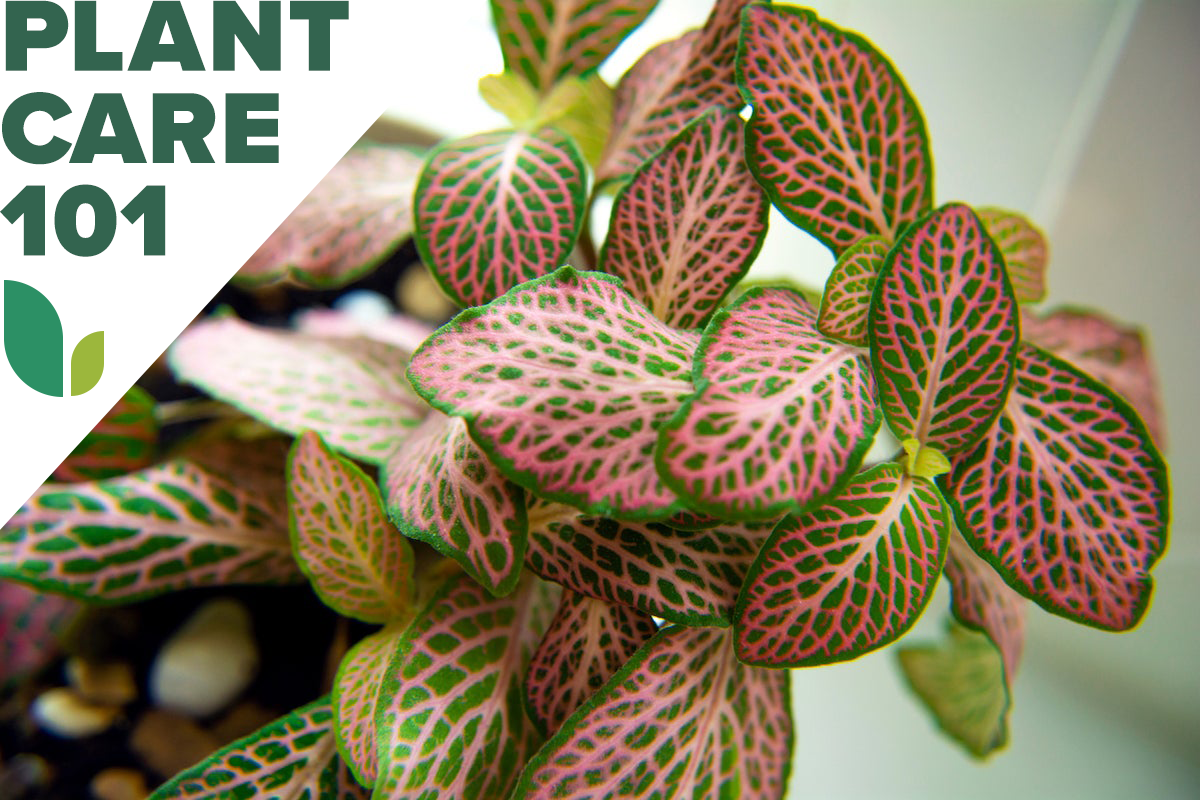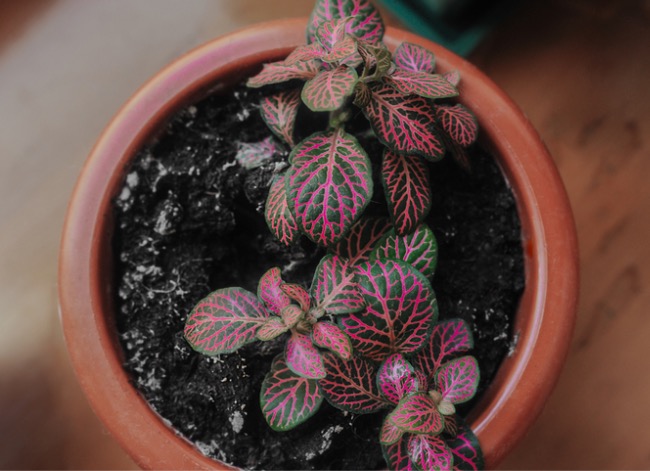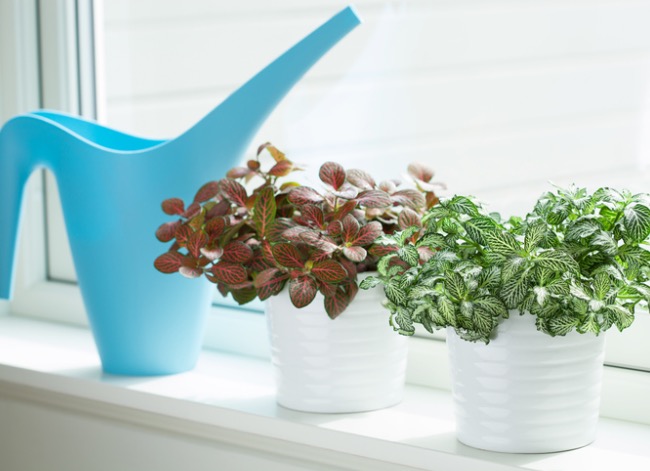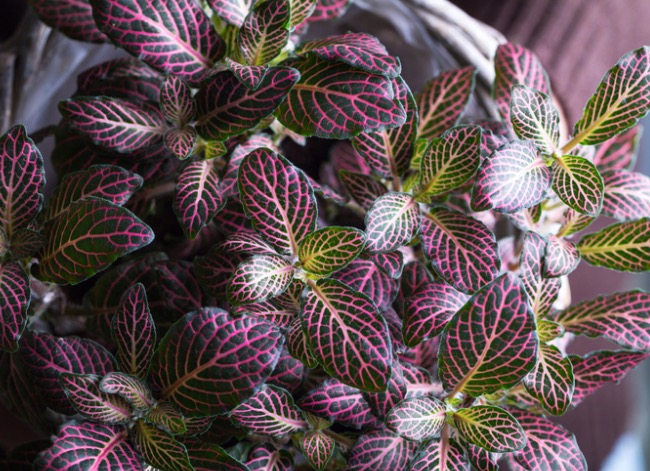

We may earn revenue from the products available on this page and participate in affiliate programs. Learn More ›
Nerve plant is one of those bright little gems that grabs your attention as you stroll through the garden center. This compact, spreading plant is known for its intense green foliage, highlighted by brightly colored leaf veins that give the impression of netting. The small size and attention-grabbing colors make nerve plants popular choices for terrariums, desktops, and for mixed foliage gardens. Don’t worry, it is not hard to grow.
If you’ve seen this plant online or at your local plant store and wondered if it is right for you, we can help. Take a quick read through the following plant profile, then go ahead and start shopping for your favorite variety. It’s likely that your home has a little space that will be just right for growing one of these little beauties.
Nerve Plant Care at a Glance
Common names: Fittonia, nerve plant, mosaic plant, net plant
Scientific names: Fittonia albivenis, Fittonia argyroneura
Soil: Consistently moist, well drained
Light: Low to medium
Water: Medium to high
Food: 20-20-20
Temperature and humidity: 70 degrees Fahrenheit, high humidity
Propagation: Seed, cuttings
Safety: Nontoxic, low allergen
Nerve Plant Characteristics
Nerve plant (Fittonia spp.), which is sometimes known as mosaic plant, net plant, or simply Fittonia, makes an excellent choice for apartments, offices, and anywhere else with limited space. This compact native of South American rainforests happily displays its colorful, patterned leaves in a variety of light conditions. It especially thrives in bright, indirect light, where it matures at 3 to 6 inches high. Even though it has tropical “roots,” nerve plant is easier to care for than some houseplants.
The light- to medium-green leaves display vivid venation in shades of either white, pink, or red. In the wild, this plant produces small bloom spikes that match and blend in with the foliage colors, but the floral display is rarely seen in cultivation. It is mostly appreciated for its uniquely attractive leaves. The slow-growing foliage features a spreading or trailing habit, and mature plants form mats from where the stems root into the soil. Plants are easily propagated from cuttings.

Types of Nerve Plants
Genetic variation abounds with this fun little plant. The variations of bright colors make this houseplant a great gift or part of a plant collection. Below are some of the many popular varieties that are readily available at garden centers and online stores.
- Fittonia ‘Angel Snow’ is a smaller silver nerve plant with rich green leaves and white veins.
- F. ‘Black Star’ features dark green leaves with bold purple and red stripes.
- F. ‘Daisy’ grows large, gray-green leaves with white veins.
- F. ‘Fortissimo’ is a large variety with green leaves and pinkish-red veins.
- F. ‘Leather Leaf’ produces large whitish foliage with bright white veins.
- F. ‘Mini Red Vein’ is a red nerve plant with small leaves and deep reddish-pink veins.
- F. ‘Pink Star’ has small, wavy leaves that are broadly veined in pink.
- F. ‘Titanic’ is a smaller variety with dark leaves veined with bright white.
Selecting Soil for Nerve Plants
Nerve plants prefer to remain evenly moist, so a spongy soil that is high in peat moss would be ideal. But, as with most plants, Fittonia suffers in soggy soil, so water retention has to be balanced with good drainage of excess moisture. High quality, pH-balanced, general purpose indoor potting soil should be sufficient. Repot your plants annually or as needed when the soil condition degrades to maintain a good moisture balance.

The Right Light
Nerve plants thrive under a wide range of light conditions from low to bright, indirect sunshine. If lighting is excessive, the foliage may begin to turn brown at the tips or take on a yellowish or tan sunburn. In extremely low light, the vein coloration will fade to green. The ideal situation would be near a brightly lit window, but behind a sheer curtain that filters the sun’s direct rays. Even then, be careful not to place the plant in an area with too-low humidity or where the soil dries too quickly.
Watering Nerve Plants
Proper watering is a critical part of Fittonia care. In a right-sized container with good soil and high humidity, the nerve plant should be able to go 4 to 7 days between waterings. Water when the soil surface begins to dry, but do not wait for it to become crusty. Timing will vary based on soil texture, ambient humidity, temperature, and numerous other factors.
If the plant needs water more than twice a week, consider making an adjustment that will reduce the need. Inspect the soil and roots to see if the plant has outgrown the pot or if the soil texture has degraded. Check the growing location to see if it gets a draft from a heating or air conditioning vent, or if it is simply too warm and dry.

Related: The 30 Best Gifts for Gardeners That They’ll Actually Use
Fertilizing Nerve Plants
Nerve plants are not known as heavy feeders, but they respond well to consistent addition of a balanced fertilizer like 20-20-20 or an equivalent. Quality potting soil includes a low-level dose of plant food that will feed for a few weeks after repotting, so new plants can go a short time without fertilizer. Going forward, add time-release fertilizer a few times during the growing season, or include a balanced liquid fertilizer in the water at regular intervals, following the manufacturer’s instructions.
Setting the Temperature and Humidity
One of the reasons nerve plants are easy to grow is because they thrive in average home temperatures of about 70 degrees Fahrenheit. If your home fluctuates between 60 and 78 degrees, the plant will do well.
Adequate humidity is critical for healthy Fittonia as well. The plants like it on the humid side, such as may be found in the kitchen or bathroom. If the soil is moist but the foliage seems to be dry at the edges, you can boost humidity in the immediate area around the plant by misting it with plain water from a spray bottle.
Another possibly more effective way to increase humidity is by placing the plant on an oversize plant saucer filled with pebbles and water. The pebbles keep the plant base out of the water and the water evaporates, moistening the air.
Propagating Nerve Plants
When a nerve plant becomes tired and leggy over time, or when your friend falls in love with your beautiful healthy plant, it is easy to grow new starts from the one you have. Fittonia grows readily from seeds or stem cuttings. Since it rarely flowers and makes seeds at home, plan on propagating from cuttings.
The easiest and fastest method of growing new Fittonia plants from cuttings is by placing them into water until roots form, then sticking the rooted cuttings into soil. Well-established plants may already have rooted stems that you can simply clip off and pot up into soil. If not, take 2- to 4-inch stem tip cuttings from healthy shoots. Remove all but the top two leaves on each cutting.
Place the cuttings into a jar of water with the top third sticking out. Place the jar of cuttings in a warm, humid location with bright, indirect light. Change the water every few days to avoid algae growth. In a few weeks, when roots begin to develop, transplant the cuttings into potting soil.
Related: 10 Houseplants You Can Propagate the Fastest for an Ever-Expanding Indoor Garden

Safety Considerations
Fittonia is considered a safe plant for most households. No known toxins are present in the plant tissue, and the allergen level is low to nonexistent as well. As always, it is best to use caution and keep children and pets away.
Potential Pests and Diseases
With proper care, Fittonias rarely encounter pest and disease problems. That said, however, some problems may arise with new plants or while transitioning to a different location. Be on guard against such bugs as fungus gnats, mealybugs, and aphids. Should an infestation arise, treat it as soon as possible with an appropriate insecticide for the target pest.
In cases of consistent overwatering or poorly drained soil, root rot may develop. Symptoms include wilting when the soil appears moist and dieback of shoots. In the early stages, root rot can be treated by repotting and revising watering habits.
FAQ About Nerve Plant Care
Looking for more information about Fittonia? Check out the answers to these frequent questions that other readers have asked.
Q. How much sun does a nerve plant need?
Nerve plants grow well in a range of light conditions, from low to bright, indirect light. Bright, indirect light is ideal.
Q. How often should I water a nerve plant?
Water your nerve plant thoroughly when the soil surface just begins to dry out. If growing conditions are favorable, watering frequency normally ranges between 4 and 7 days, or slightly longer.
Q. Does Fittonia need sunlight?
Fittonia does not grow well in direct sunlight. It needs filtered light to eliminate the chance of sunburn on the foliage. Placing it behind a sheer curtain or across the room from a bright window should prevent sunburn.
Q. Is nerve plant an indoor or outdoor plant?
Nerve plant is a tropical plant that grows well in low to medium light. It needs average temperatures around 70 degrees and high humidity. It thrives as a houseplant where it receives bright, indirect sunlight and enough water and humid air. In some regions, you can place the plant outdoors during the warmest summer months. It can survive outdoors only in growing zones 11 and 12.
Looking for more easy-care houseplants? Check out our guides on caring for ZZ plant, snake plant, and pothos.
